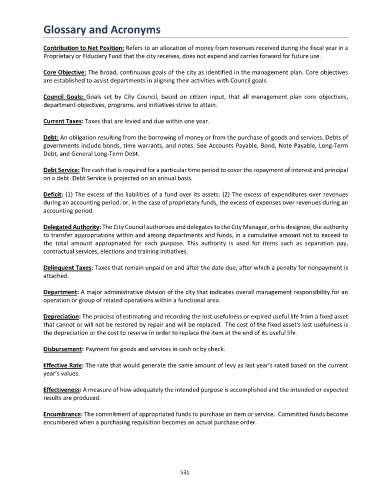Page 570 - Fort Worth City Budget 2019
P. 570
Glossary and Acronyms
Contribution to Net Position: Refers to an allocation of money from revenues received during the fiscal year in a
Proprietary or Fiduciary Fund that the city receives, does not expend and carries forward for future use.
Core Objective: The broad, continuous goals of the city as identified in the management plan. Core objectives
are established to assist departments in aligning their activities with Council goals.
Council Goals: Goals set by City Council, based on citizen input, that all management plan core objectives,
department objectives, programs, and initiatives strive to attain.
Current Taxes: Taxes that are levied and due within one year.
Debt: An obligation resulting from the borrowing of money or from the purchase of goods and services. Debts of
governments include bonds, time warrants, and notes. See Accounts Payable, Bond, Note Payable, Long-Term
Debt, and General Long-Term Debt.
Debt Service: The cash that is required for a particular time period to cover the repayment of interest and principal
on a debt. Debt Service is projected on an annual basis.
Deficit: (1) The excess of the liabilities of a fund over its assets. (2) The excess of expenditures over revenues
during an accounting period, or, in the case of proprietary funds, the excess of expenses over revenues during an
accounting period.
Delegated Authority: The City Council authorizes and delegates to the City Manager, or his designee, the authority
to transfer appropriations within and among departments and funds, in a cumulative amount not to exceed to
the total amount appropriated for each purpose. This authority is used for items such as separation pay,
contractual services, elections and training initiatives.
Delinquent Taxes: Taxes that remain unpaid on and after the date due, after which a penalty for nonpayment is
attached.
Department: A major administrative division of the city that indicates overall management responsibility for an
operation or group of related operations within a functional area.
Depreciation: The process of estimating and recording the lost usefulness or expired useful life from a fixed asset
that cannot or will not be restored by repair and will be replaced. The cost of the fixed asset's lost usefulness is
the depreciation or the cost to reserve in order to replace the item at the end of its useful life.
Disbursement: Payment for goods and services in cash or by check.
Effective Rate: The rate that would generate the same amount of levy as last year’s rated based on the current
year’s values.
Effectiveness: A measure of how adequately the intended purpose is accomplished and the intended or expected
results are produced.
Encumbrance: The commitment of appropriated funds to purchase an item or service. Committed funds become
encumbered when a purchasing requisition becomes an actual purchase order.
531

